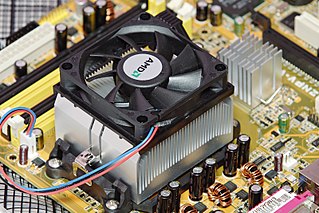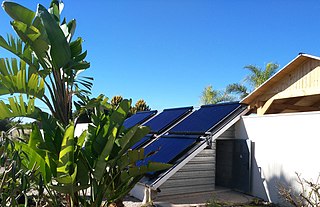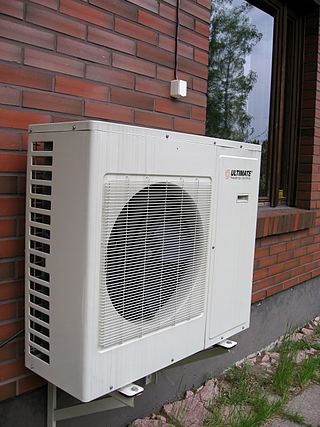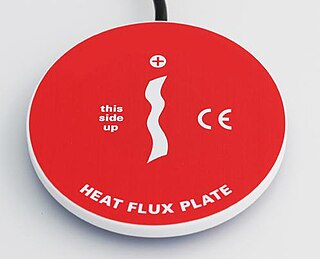Related Research Articles
The thermal conductivity of a material is a measure of its ability to conduct heat. It is commonly denoted by , , or .
Conduction is the process by which heat is transferred from the hotter end to the colder end of an object. The ability of the object to conduct heat is known as its thermal conductivity, and is denoted k.

A heat sink is a passive heat exchanger that transfers the heat generated by an electronic or a mechanical device to a fluid medium, often air or a liquid coolant, where it is dissipated away from the device, thereby allowing regulation of the device's temperature. In computers, heat sinks are used to cool CPUs, GPUs, and some chipsets and RAM modules. Heat sinks are used with high-power semiconductor devices such as power transistors and optoelectronics such as lasers and light-emitting diodes (LEDs), where the heat dissipation ability of the component itself is insufficient to moderate its temperature.

Solar water heating (SWH) is heating water by sunlight, using a solar thermal collector. A variety of configurations are available at varying cost to provide solutions in different climates and latitudes. SWHs are widely used for residential and some industrial applications.
The coefficient of performance or COP of a heat pump, refrigerator or air conditioning system is a ratio of useful heating or cooling provided to work (energy) required. Higher COPs equate to higher efficiency, lower energy (power) consumption and thus lower operating costs.

Thermal energy storage (TES) is achieved with widely different technologies. Depending on the specific technology, it allows excess thermal energy to be stored and used hours, days, months later, at scales ranging from the individual process, building, multiuser-building, district, town, or region. Usage examples are the balancing of energy demand between daytime and nighttime, storing summer heat for winter heating, or winter cold for summer air conditioning. Storage media include water or ice-slush tanks, masses of native earth or bedrock accessed with heat exchangers by means of boreholes, deep aquifers contained between impermeable strata; shallow, lined pits filled with gravel and water and insulated at the top, as well as eutectic solutions and phase-change materials.

Electric heating is a process in which electrical energy is converted directly to heat energy. Common applications include space heating, cooking, water heating and industrial processes. An electric heater is an electrical device that converts an electric current into heat. The heating element inside every electric heater is an electrical resistor, and works on the principle of Joule heating: an electric current passing through a resistor will convert that electrical energy into heat energy. Most modern electric heating devices use nichrome wire as the active element; the heating element, depicted on the right, uses nichrome wire supported by ceramic insulators.
Renewable heat is an application of renewable energy referring to the generation of heat from renewable sources; for example, feeding radiators with water warmed by focused solar radiation rather than by a fossil fuel boiler. Renewable heat technologies include renewable biofuels, solar heating, geothermal heating, heat pumps and heat exchangers. Insulation is almost always an important factor in how renewable heating is implemented.

Underfloor heating and cooling is a form of central heating and cooling that achieves indoor climate control for thermal comfort using hydronic or electrical heating elements embedded in a floor. Heating is achieved by conduction, radiation and convection. Use of underfloor heating dates back to the Neoglacial and Neolithic periods.
A thermal energy battery is a physical structure used for the purpose of storing and releasing thermal energy—see also thermal energy storage. Such a thermal battery allows energy available at one time to be temporarily stored and then released at another time. The basic principles involved in a thermal battery occur at the atomic level of matter, with energy being added to or taken from either a solid mass or a liquid volume which causes the substance's temperature to change. Some thermal batteries also involve causing a substance to transition thermally through a phase transition which causes even more energy to be stored and released due to the delta enthalpy of fusion or delta enthalpy of vaporization.
The thermal properties of soil are a component of soil physics that has found important uses in engineering, climatology and agriculture. These properties influence how energy is partitioned in the soil profile. While related to soil temperature, it is more accurately associated with the transfer of energy throughout the soil, by radiation, conduction and convection.
Seasonal thermal energy storage (STES), also known as inter-seasonal thermal energy storage, is the storage of heat or cold for periods of up to several months. The thermal energy can be collected whenever it is available and be used whenever needed, such as in the opposing season. For example, heat from solar collectors or waste heat from air conditioning equipment can be gathered in hot months for space heating use when needed, including during winter months. Waste heat from industrial process can similarly be stored and be used much later or the natural cold of winter air can be stored for summertime air conditioning.

Geotechnical investigations are performed by geotechnical engineers or engineering geologists to obtain information on the physical properties of soil earthworks and foundations for proposed structures and for repair of distress to earthworks and structures caused by subsurface conditions; this type of investigation is called a site investigation. Geotechnical investigations are also used to measure the thermal resistance of soils or backfill materials required for underground transmission lines, oil and gas pipelines, radioactive waste disposal, and solar thermal storage facilities. A geotechnical investigation will include surface exploration and subsurface exploration of a site. Sometimes, geophysical methods are used to obtain data about sites. Subsurface exploration usually involves soil sampling and laboratory tests of the soil samples retrieved.

An air source heat pump (ASHP) is a type of heat pump that can absorb heat from outside a structure and release it inside using the same vapor-compression refrigeration process and much the same equipment as air conditioners but used in the opposite direction. Unlike an air conditioning unit, most ASHPs are reversible and are able to either warm or cool buildings and in some cases also provide domestic hot water.

A ground source heat pump is a heating/cooling system for buildings that uses a type of heat pump to transfer heat to or from the ground, taking advantage of the relative constancy of temperatures of the earth through the seasons. Ground source heat pumps (GSHPs) – or geothermal heat pumps (GHP) as they are commonly termed in North America – are among the most energy-efficient technologies for providing HVAC and water heating, using far less energy than can be achieved by burning a fuel in a boiler/furnace or by use of resistive electric heaters.

A heat flux sensor is a transducer that generates an electrical signal proportional to the total heat rate applied to the surface of the sensor. The measured heat rate is divided by the surface area of the sensor to determine the heat flux.
There are a number of possible ways to measure thermal conductivity, each of them suitable for a limited range of materials, depending on the thermal properties and the medium temperature. Three classes of methods exist to measure the thermal conductivity of a sample: steady-state, time-domain, and frequency-domain methods.
Heat exchangers are devices that transfer heat to achieve desired heating or cooling. An important design aspect of heat exchanger technology is the selection of appropriate materials to conduct and transfer heat fast and efficiently.
The Glossary of Geothermal Heating and Cooling provides definitions of many terms used within the Geothermal heat pump industry. The terms in this glossary may be used by industry professionals, for education materials, and by the general public.
Renewable thermal energy is the technology of gathering thermal energy from a renewable energy source for immediate use or for storage in a thermal battery for later use.
References
- ↑ "Simple search". epubl.ltu.se. Retrieved 2018-03-12.
- ↑ Mogensen P. 1983. Fluid to Duct Wall Heat Transfer in Duct System Heat Storage. Proc. Int. Conf. On Subsurface Heat Storage in Theory and Practice. Stockholm. Sweden, June 6–8, 1983. PP: 652-657.
- ↑ "Thermal Response Testing - Carbon Zero Consulting". Carbon Zero Consulting. Retrieved 2018-03-12.
- ↑ Gehlin S. 2002. Thermal Response Teast, Meathod Development and Evaluation. Doctoral Thesis 2002:39. Luleå University of Technology. Sweden.
- ↑ Sanner, Burkhard; Hellström, Göran; Spitler, Jeff; Gehlin, Signhild (April 2005). Thermal Response Test – Current Status and World-Wide Application (PDF). Proceedings World Geothermal Congress 2005. CiteSeerX 10.1.1.702.2864 .
- ↑ Kharseh, M. (2009). Reduction of Prime Energy Consumption in the Middle East by GSHP Systems. Department of Civil, Mining and Environmental Engineering. Luleå University of Technology Luleå .
- ↑ Yu, Xiaohui; Zhang, Yufeng; Deng, Na; Ma, Hongting; Dong, Shengming (2016). "Thermal response test for ground source heat pump based on constant temperature and heat-flux methods". Applied Thermal Engineering. 93: 678–682. doi:10.1016/j.applthermaleng.2015.10.007.